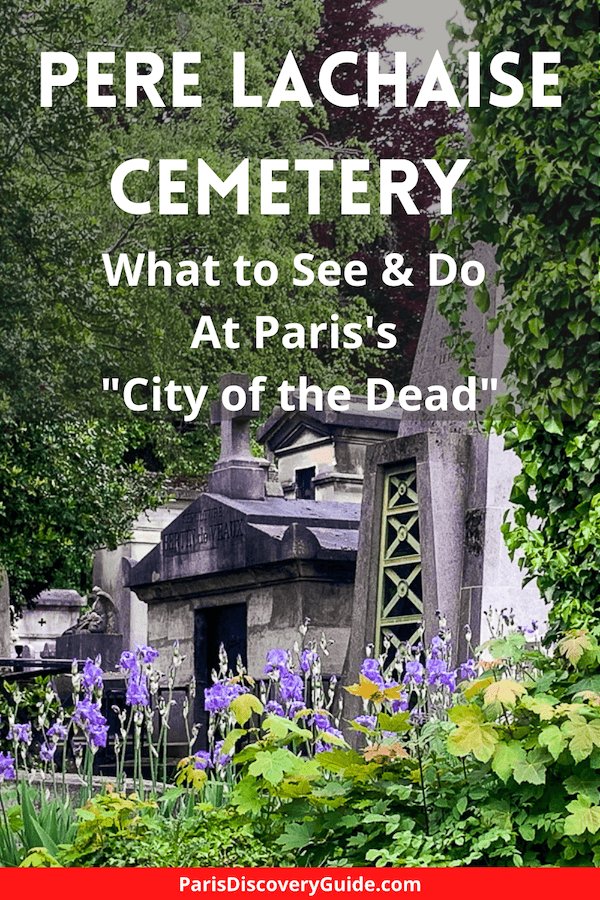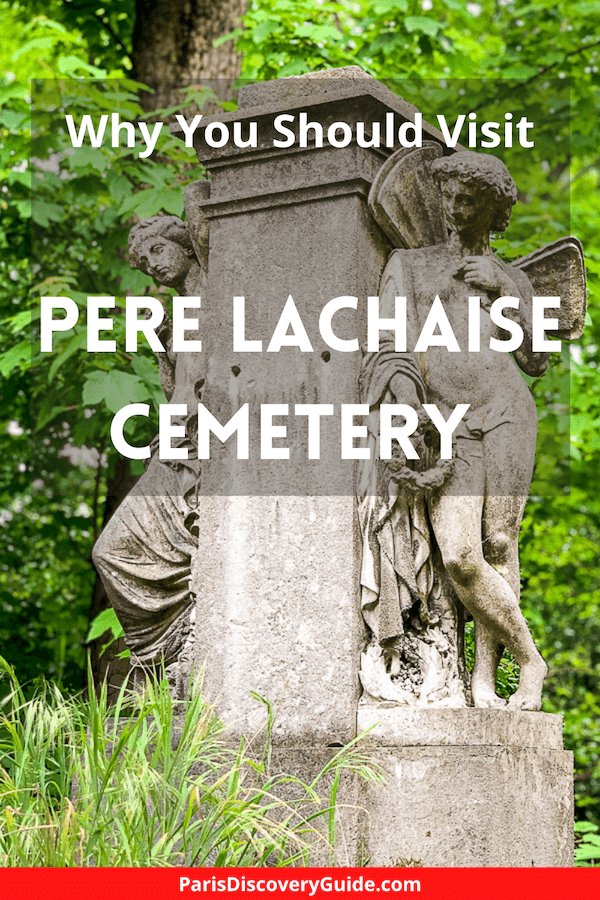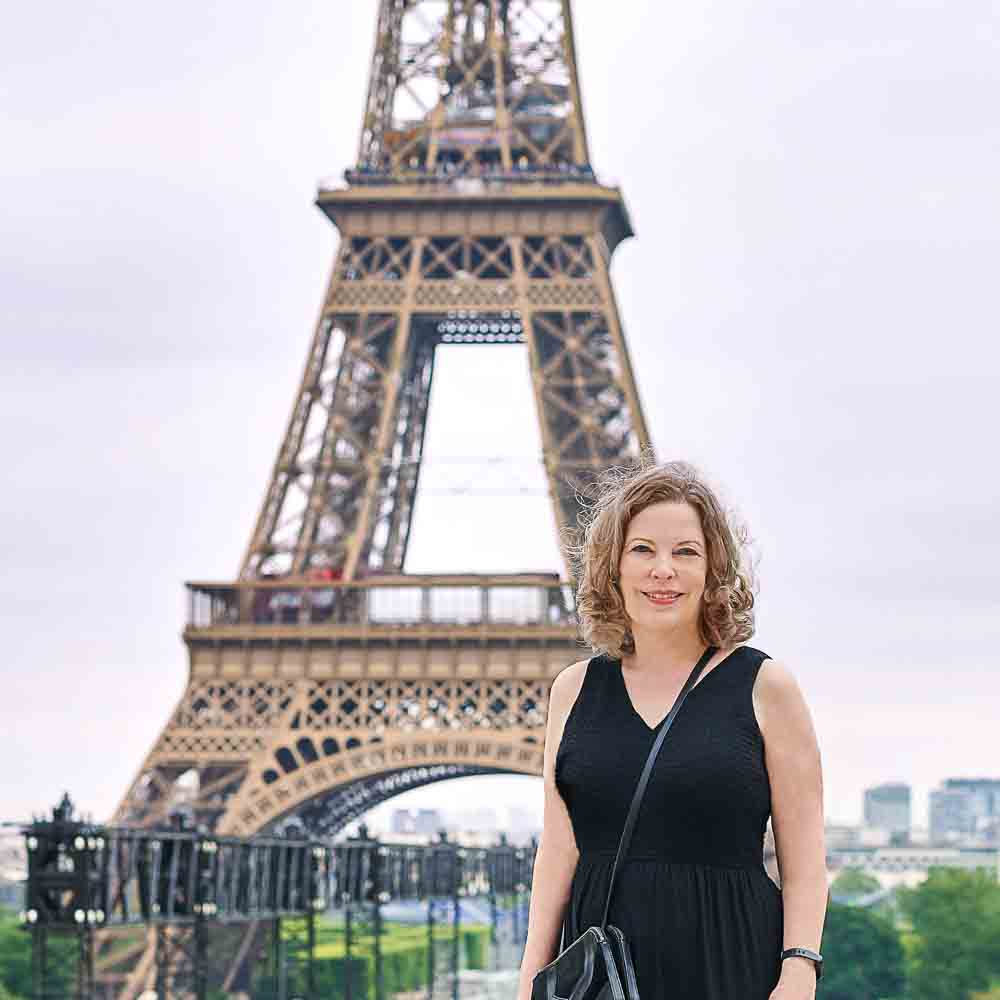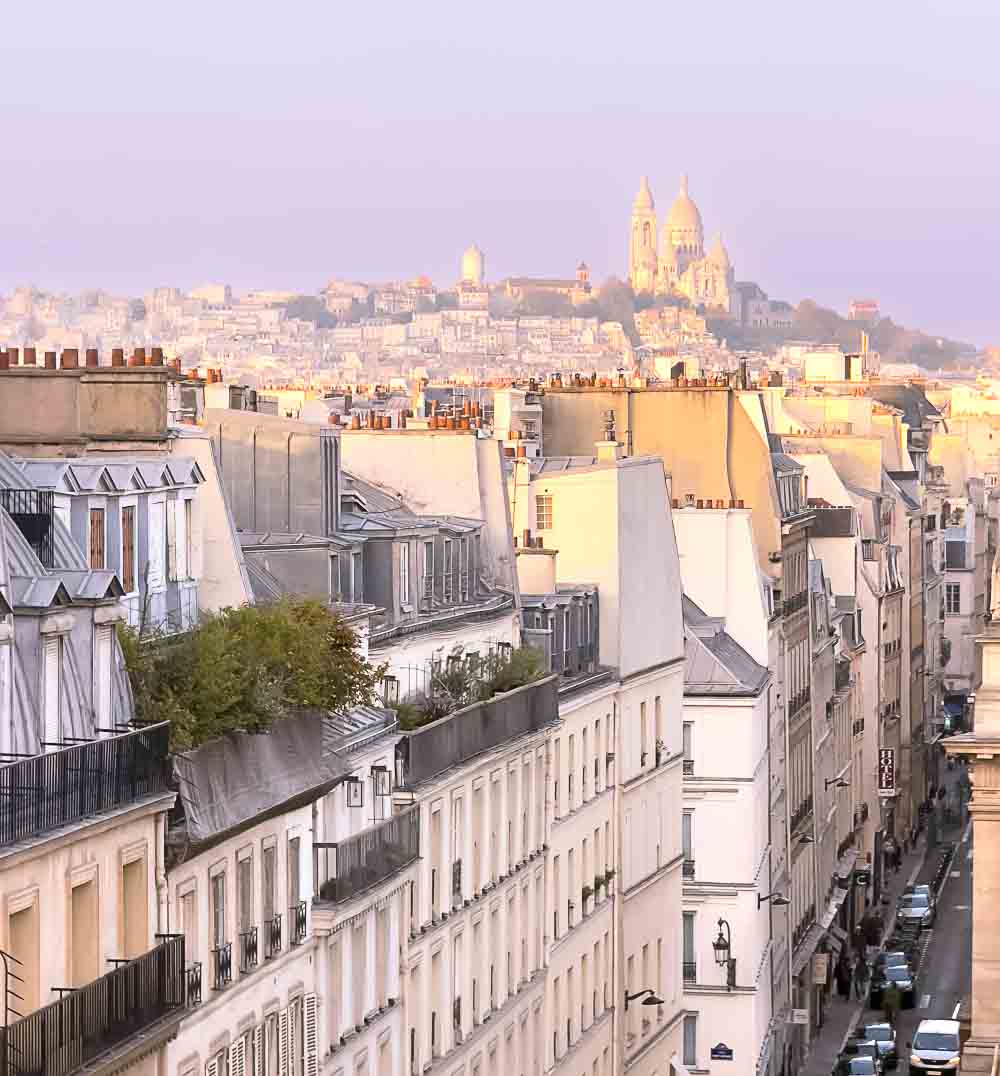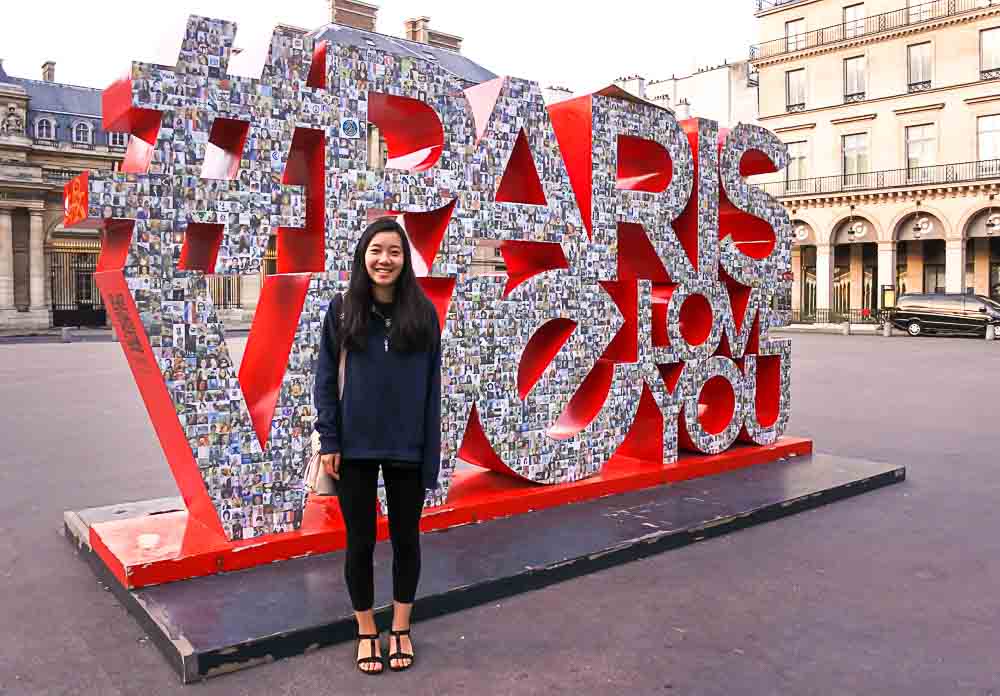Even though Père Lachaise Cemetery (Cimetière du Pete Lachaise) in eastern Paris may not be quite as famous as the Eiffel Tower or Arc de Triomphe, its combination of celebrity graves, haunting statues, lush landscaping, and photo-worthy cobblestone lanes make it a top Paris attraction as well as the most visited burial ground in the world, attracting around 3.5 million visitors each year.
Wander along the winding paths criss-crossing the cemetery's rolling slopes, and you'll see elaborate sepulchres, family chapels, and poignant memorials featuring some of the world's best funerary architecture and art in an astounding array of styles: Romanesque, Medieval Gothic, Neoclassic, Italian Renaissance, Second Empire, Eastern Orthodox domes, and Art Nouveau, just to name a few.
An increasing number of sleekly contemporary granite slabs act as reminders that Père Lachaise continues to welcome new permanent residents.
Book Your Pete Lachaise Tour Now
- Père Lachaise Cemetery Guided Small Group Tour - During this 2-hour guided tour, you'll see the graves of Jim Morrison, Oscar Wilde, Chopin, Edith Piaf, and many other famous artists, writers, & musicians
- Haunted Père Lachaise Cemetery Guided Tour - Fun, freaky, & macabre - you'll find out about all the spooky secrets at Pete Lachaise on this popular and fascinating tour
- Stories of Père Lachaise Cemetery Walking Tour - Explore the famous cemetery while your guide shares stories about the scandals, heroism, tragedies, and accomplishments of the fascinating people buried here
Almost everywhere you look, you'll spot sculptures of every size and shape imaginable: plump winged cherubs, macabre skulls flanked by what appear to be bat wings, scantily clad women sprawled across tombstones, disembodied heads of famous men.
Many are beautiful and touching; some are downright weird.
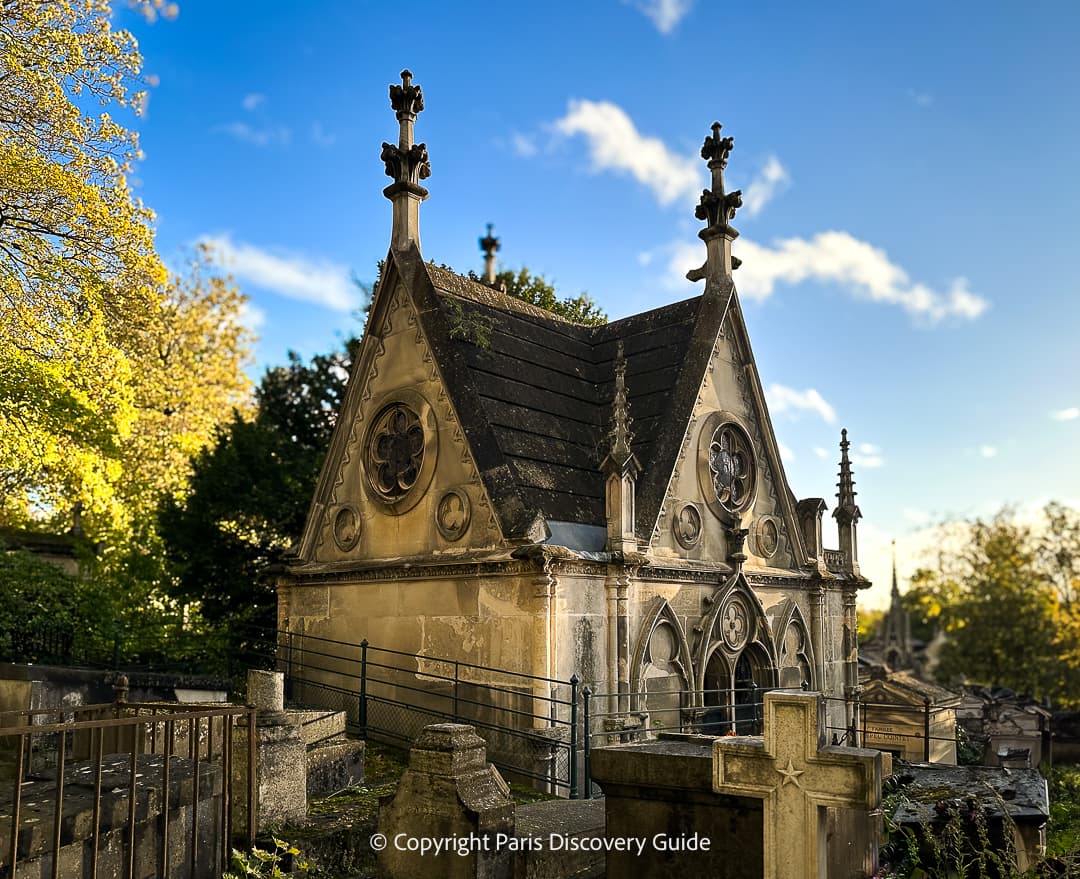
If you're a nature lover, you'll appreciate the beauty of the cemetery's specimen trees, beautiful plants, birds, and other wildlife.
If you're a historian, you may swoon over the wide swath of French cultural, political, and scientific achievements represented by the illustrious occupants.
If you're an artist, you may want to bring paints, a canvas, and an easel.
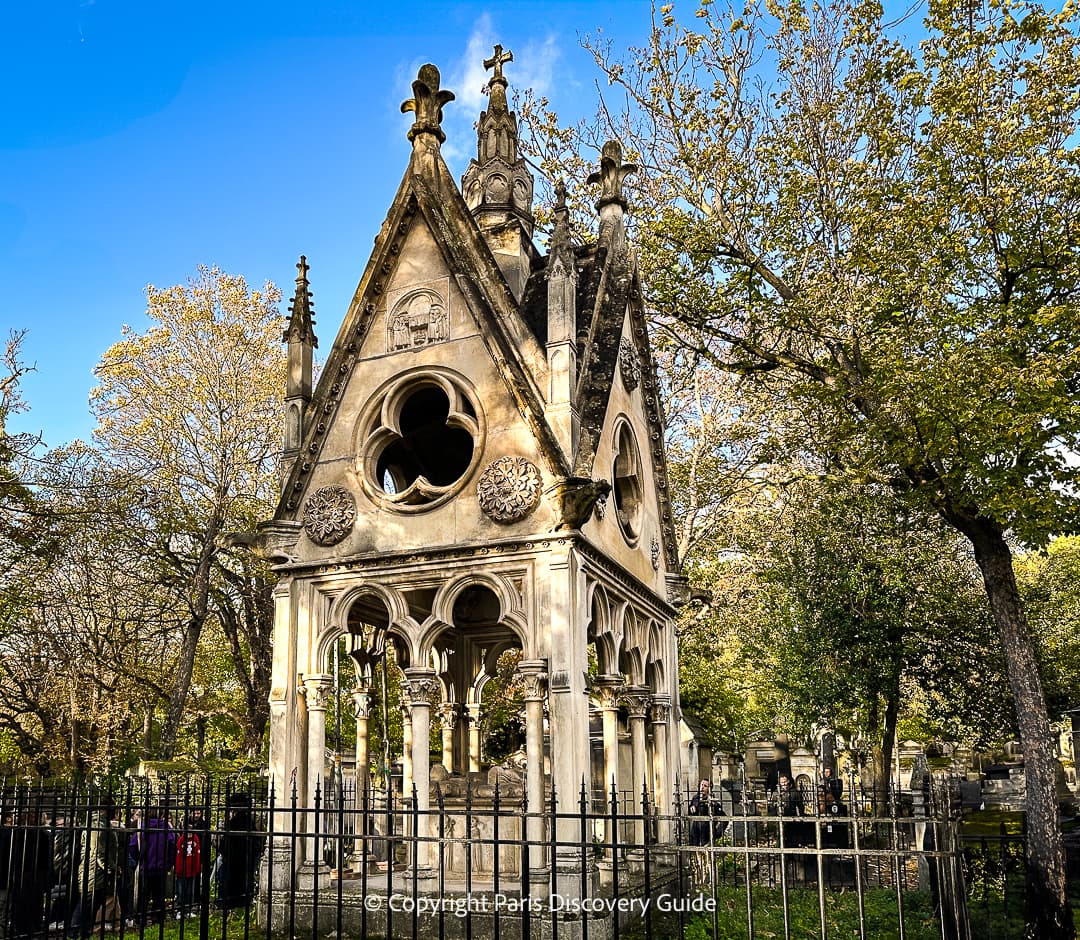
But if you're like most first-time visitors to this "City of the Dead," you probably want to see the graves of famous people buried here.
Find out about 101 famous graves at Pere Lachase Cemetery
And you'll find plenty. Jim Morrison of The Doors draws the biggest crowds among Americans. Among UK visitors, Oscar Wilde's tomb attracts avid fans. Opera lovers from everywhere pay homage at the columbarium niche of Maria Callas. And singer Edith Piaf is a perennial favorite of French visitors, while Ahmet Kaya's memorial is a current attraction.
There are plenty more: stage and movie stars such as Sarah Bernhardt, Simone Signoret, and Yves Montand, writers, artists, and composers like Colette, Gertrude Stein, Modigliani, Chopin, and Rossini, and numerous politicians, philosophers, scientists, revolutionaries, inventors, gourmands, military heroes, and business tycoons.
In this article, we share:
- Tips about the best ways to start exploring this immense City of the Dead, plus a downloadable printable map to get you started
- Essential visitor information
- A short list of the cemetery's most famous eternal residents (or check our longer article with details about 101 famous graves at Pete Lachaise)
- Fun and fascinating facts about the cemetery
- Where to eat, stay, and buy floral arrangements nearby
Top photo: Family sepulchers at Cimetière Père-Lachaise in early March
Paris Discovery Guide is a reader-supported publication. When you buy through my links, I may earn a small commission at no additional cost to you. Merci beaucoup for your support!
Best Ways to See Père Lachaise Cemetery
What's the best way to see the top attractions at Père Lachaise, especially if you're planning your first visit?
Although you can try locating specific tombs with a graveyard map (you'll find one of the best Père Lachaise maps further down in this article), it's not as easy as you might expect because the cemetery packs 70,000 burial plots into its 106 acres (43 hectares).
To make the most of your time, join one of the popular Père Lachaise Cemetery group or private tours. Your guide will know the best routes and shortcuts to take you to the most famous graves plus those with the especially fantastic sculptures and memorials, and will also entertain you with stories about the fascinating and sometimes eccentric people buried here.
Most Popular Pete Lachaise Cemetery Tours:
Once you've taken a tour, you'll have a much better sense of the cemetery's most interesting sights and you can explore more on your own. Just don't be surprised if Père Lachaise draws you back for another visit every time you're in Paris, because you're sure to discover new things each time you come.
1. Tour Père Lachaise with a Guide
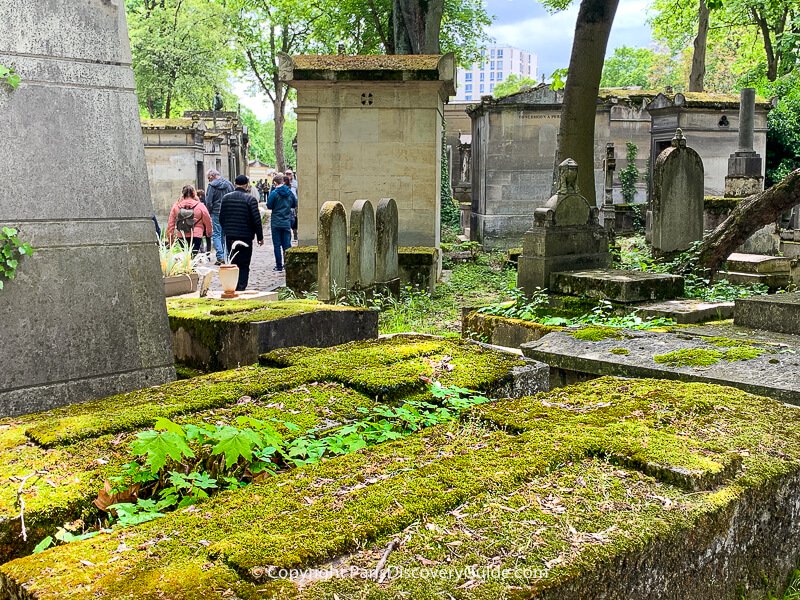
Starting with a guided tour is the best choice if you're making your first or second visit and you want to see as much as possible in a limited amount of time.
Your guide will bring this "City of the Dead" to life for you with anecdotes about the cemetery and its permanent residents, and you'll see things you might not find nearly as quickly on your own. A few of the celebrity graves can be especially difficult to locate.
Although the cemetery itself doesn't give tours, professional guides offer options for you to book in advance. Here are two of the most popular choices:
- Père Lachaise Cemetery Guided Tour - During this popular walking tour, you'll visit final resting places and hear fascinating stories of great men and women from the worlds of art, music, literature, and history, such as Jim Morrison, Oscar Wilde, Edith Piaf, Chopin, and more - Group of up to 20
- Haunted Père Lachaise Cemetery Guided Tour - Fun, freaky, & macabre - you'll find out about all the spooky secrets at Pete Lachaise on this popular and fascinating tour
- Stories of Père Lachaise Cemetery Walking Tour - Explore the famous cemetery while your guide entertains you with stories about the scandals, secrets, heroism, tragedies, and accomplishments of the fascinating people buried here
Does Père Lachaise offer "official" tours or "accredited" guides?
No. If you're approached by someone in the cemetery representing themselves as an "official" tour guide or "accredited" Père Lachaise guide and offering to show you around the cemetery, this is a scam of sorts. If you agree on go on their "tour," they may show you 2-3 things (if you're American, they'll usually take you Jim Morrison's tomb), and then hit you up for a hefty tip.
If all you want to see is Jim Morrison's grave, download a Père Lachaise map and find it on your own.
If you want to take a high-quality (and more factually accurate) guided tour where you'll see a much larger number of tombs and memorials, book in advance with a professional.
2. Be a Flâneur & Ramble on Your Own
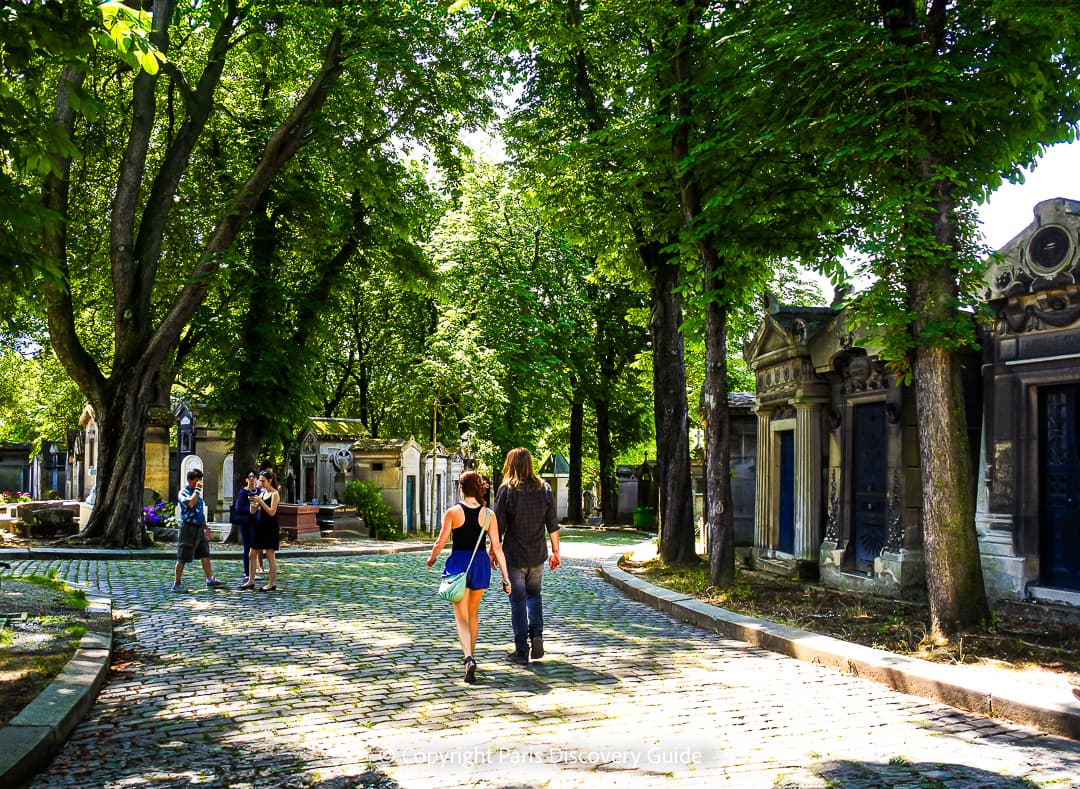
Père Lachaise Cemetery provides the perfect place for flânerie - strolling around and observing all your surroundings.
Whether you've already taken a guided tour and want to see more on your own or just want to walk around one of the most beautiful sites in Paris, you're almost guaranteed to find fascinating sights among Père Lachaise's rolling hills, winding paths, and 70,000 burial sites.
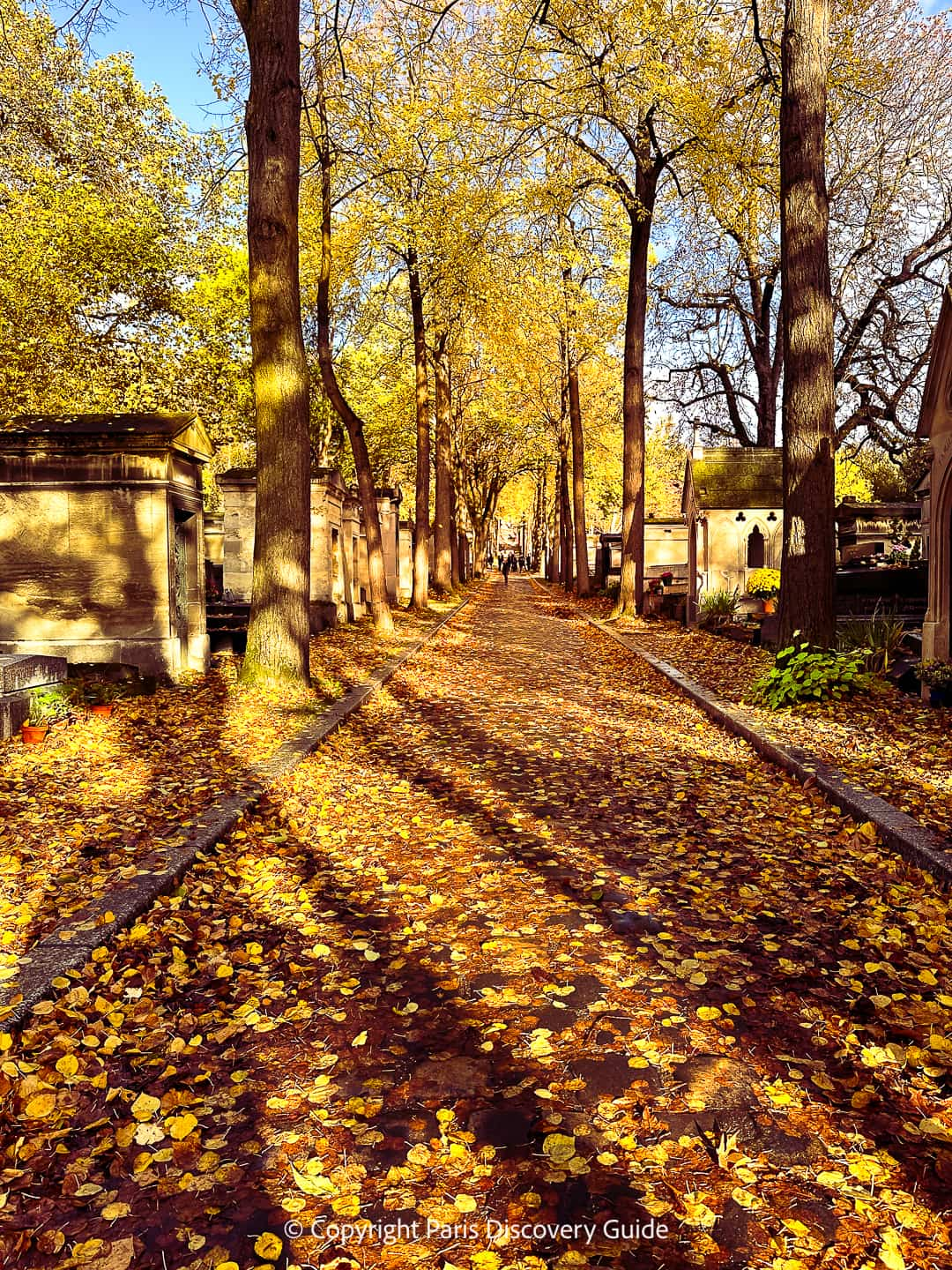
Is aimless wandering the best or most efficient way to find specific memorials? No, of course not.
But it is the perfect way to absorb the beauty and poignancy of Père Lachaise, and you're sure to stumble across (hopefully not literally) some fascinating tombs and monuments - as well as breath-taking vistas.
3. Use a Printable Map of Père Lachaise Cemetery to Find Your Favorite Celebrity Graves
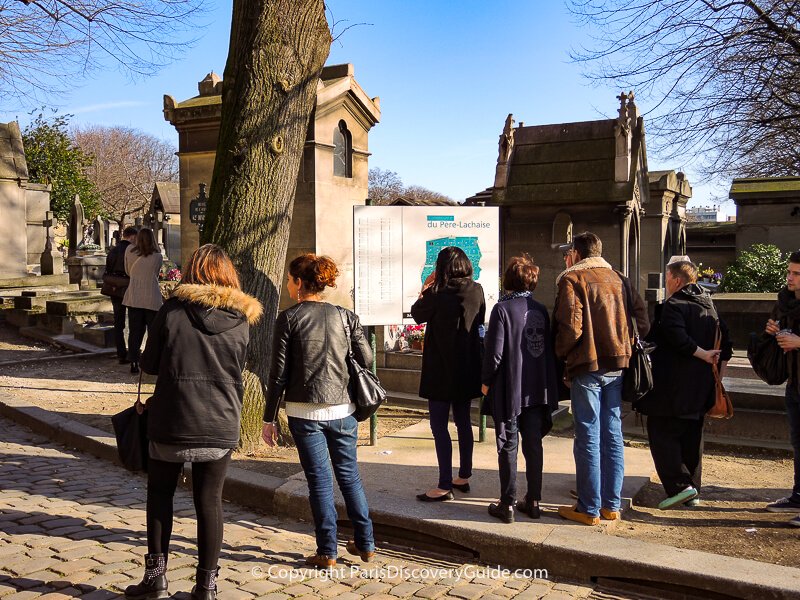
Can you find the final resting spots of the graveyard's most famous residents on your own, without a guide? Yes - although be prepared to have to spend more time that you might expect looking for some of the harder-to-find graves.
First, you'll need a map. You can find a map posted near most of the entrances and, if you like, take a photo of it with your phone as you'll see lots of other people doing.
However, having your own printed map is a lot more convenient and a lot easier to read.
Although the cemetery doesn't provide printed maps to visitors on site, they do provide an excellent free map online showing the cemetery's layout and locations of the most famous celebrity burial sites.
Here what the English version looks like:
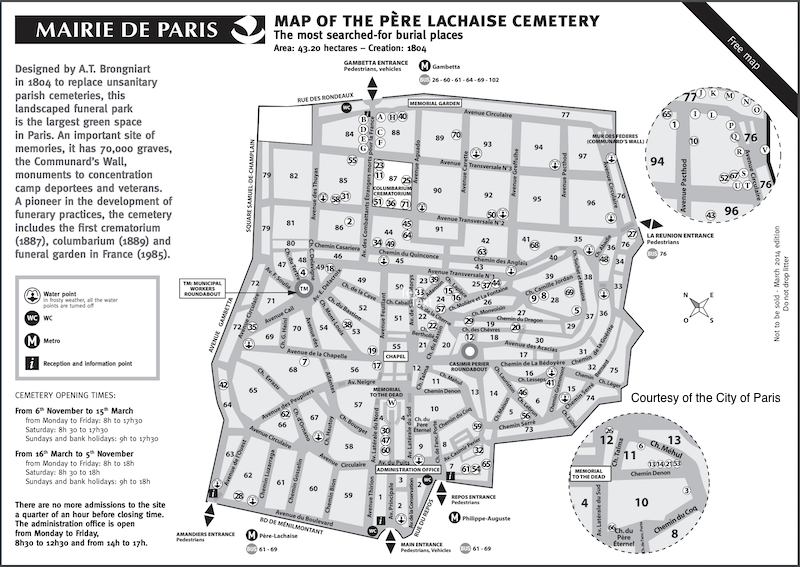
Here is the text version in English describing the most famous occupants of Pete Lachaise and the divisions where their graves are located:
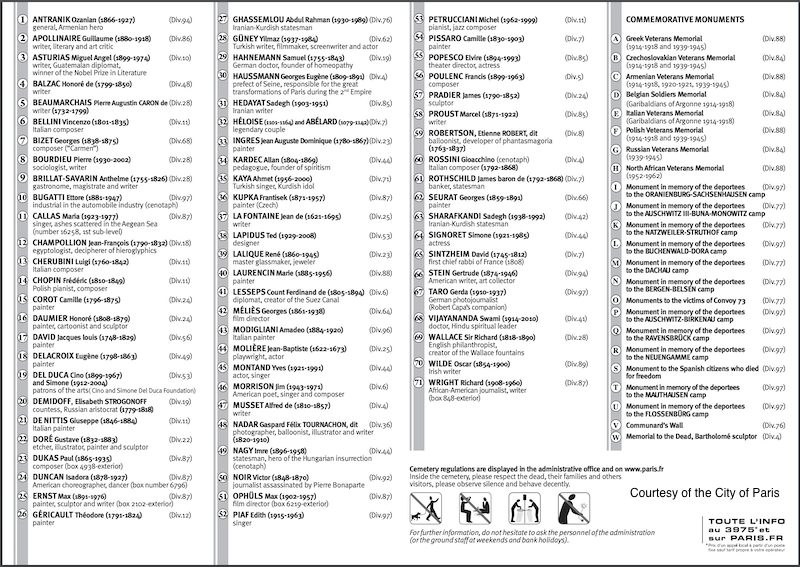
You can download this printable Pete Lachaise Cemetery map (English version) with locations of famous graves (English language version) here. (It is also available on the City of Paris website.)
If you don't have a chance to print a copy of the grave location map before your visit, you can usually buy a similar map for 10-20 euros at many of the small florist shops along the streets surrounding the cemetery.
The news kiosk next to the Pete Lachaise metro station often has maps as well.
Once you have a map in hand, all you need to do is identify the divisions where the tombs and memorials you want to visit are located, and then plot your walking route.
But here's the catch: using the map to find specific divisions is easy - but with 70,000 burial plots crowded into Pete Lachaise's 97 divisions, that means that each division holds on average over 700 gravestones, tombs, family sepulchres, and memorials.
See all the paths marked on the map? Stretched out end to end, they would cover about 10 miles. Be prepared that in many cases, finding a particular burial site can take longer - sometimes much, much longer - and require more walking and retracing your steps than you might possibly expect.
That's why starting with a guided tour is almost always a good idea, especially if you want to see multiple graves and have a limited amount of time.
Père Lachaise Visitor Information: Location, Interactive Map, Opening Hours
Admission: Free
Schedule:
- Opens at 8am Monday-Friday, 8:30am on Saturday, 9am on Sunday
- Closes at 5:30pm from November through mid-March, and at 6pm from mid-March through October
-
Last admission is 15 minutes before closing
Location: 20th Arrondissement
Entrances (Portes):
- Porte Principale - Main entrance - 21 Boulevard de Ménilmontant, across from Rue de la Roquette (Metro: Philippe Auguste or Père-Lachaise)
- Porte du Repos -
16 Rue du Repos (Metro: Philippe August)
- Porte de la Réunion - Look for this entrance where Rue de la Réunion dead-ends at the cemetery; not accessible due to a flight of stairs if you have reduced mobility
- Porte des Amandiers - Boulevard de Ménilmontant, across from Père-Lachaise metro station; not accessible due to a flight of stairs if you have reduced mobility (Metro: Père-Lachaise)
- Porte Gambetta - Rue des Rondeaux, opposite Avenue du Père Lachaise (Metro: Gambetta)
Toilet locations: Near the Porte Principal (Main Entrance) and Gambetta entrance, and at the Conservation Center; make sure you have a couple of tissues in case of no toilet paper
Rules: Picnics, jogging/running, drinking alcoholic beverages, and lying or sitting on the grass are prohibited due to being disrespectful
Interactive Map Showing Père Lachaise Cemetery, Entrance Locations, and Closest Metro Stations
Things to Know Before Your Visit
- Despite being a popular attraction for Paris residents and tourists, Père Lachaise is an active cemetery, not a park or open air museum, and its administrators prohibit anything that might disturb the tranquility. This includes music, loud noises of any sort, and consumption of food or beverages aside from water (in other words, don't bring a picnic lunch). Feeding animals by tossing or throwing food and climbing or sitting on tombs is prohibited. Bicycles, scooters, cars (unless you're 75 or older, or disabled, and have documentation to prove this), and anything else on wheels such as skate boards are banned, as are dogs (even if they're on leashes), running, and jogging. Scavenger hunts and treasure hunts are emphatically prohibited. Stick to the paths as you walk around. Don't step on the graves. Don't do gravestone rubbings.
- Wear sturdy walking shoes, as you will likely be walking on cobblestones and may also encounter rough or uneven terrain.
- If you have reduced mobility or balance concerns, be aware that even if you avoid the stairs at the Réunion and Amandiers entrances, other parts of the the cemetery also have stairs as well as uneven dirt or cobblestone paths and may therefore be inaccessible to you. This is really only a problem if you want to view graves in the inaccessible areas - otherwise, there's plenty to see from the flatter, smoother paths.
- Père Lachaise has public restrooms by the Main, Réunion, and Gambetta entrances and 24 drinking fountains scattered throughout the park. Most fountains get turned off during winter months and occasionally at other times, so bring your own water bottle. Make sure you have a couple of tissues in case there are none in the restrooms.
- In the case of strong wind, snow, ice, or other extreme weather, the cemetery will be closed.
- Don't forget, if you want a map showing where to find the most famous burial sites, you can download and print the free official Père Lachaise celebrity grave locations map here.
10 Famous Celebrities Buried in Père Lachaise
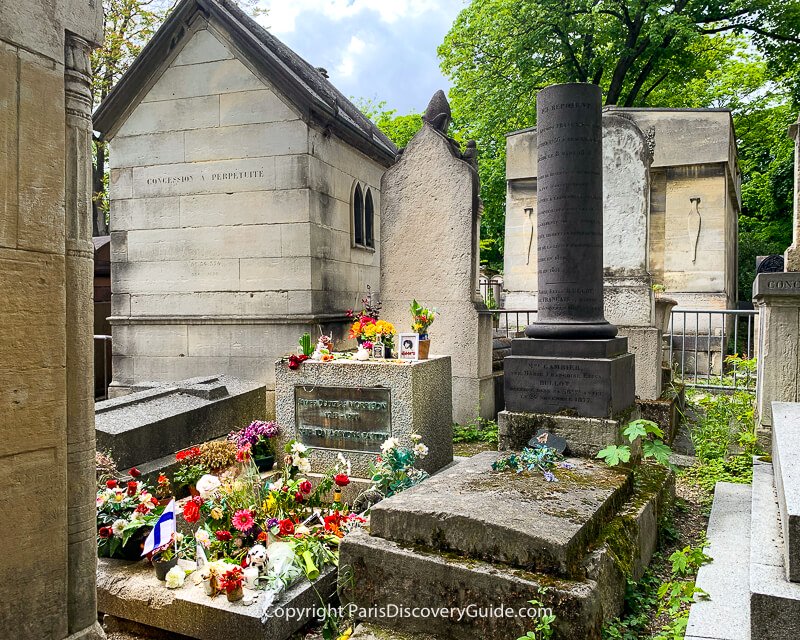
With literally thousands of well-known public figures and celebrities buried in Père Lachaise Cemetery during the past two centuries, which famous graves attract the most attention from visitors today?
There's little dispute that American rock star Jim Morrison of The Doors continues to reign supreme half a century after his death with Oscar Wilde's much-vandalized tomb a close second, but what other celebrity graves attract crowds?
To find out, we turned to internet search data. How many of these sought-after graves might be on your own bucket list to see at Père Lachaise?
Here's the "top 10" list with the division where each famous occupant is buried:
- Jim Morrison, singer/songwriter, frontman for The Doors, rock star (Division 6)
- Oscar Wilde, Irish playwright, novelist, journalist and poet who fled to Paris after being imprisoned in the UK for being gay (Division 89)
- Ahmet Kaya, sang and recorded in his native Kurdish in Turkey, fled to Paris following political persecution (Division 71)
- Edith Piaf, singer/songwriter, most popular entertainer in France after World War II - Division 97
- Allan Kardec, founder of Spiritism, and promoter of communicating with the Dead through mediums and seances (Division 44)
- Victor Noir, journalist killed by Napoleon III's cousin; the realistically detailed sculpture of him on his tomb attracts numerous visitors (Division 92)
- Abelard and Heloise, star-crossed Medieval lovers who were separated in life but now united in death (Division 7)
- Chopin, Polish composer and pianist who epitomized the Romantic era (Division 11)
- Marcel Proust, author of "Remembrance of Things Past," but perhaps best remembered today for his memories of madeleines (Division 85)
- Pete Lachaise Holocaust Memorials, haunting monuments honoring deportees from France to Nazi death camps during World War II (Divisions 77 and 97)
Want to know more? Check out 101 famous and celebrity graves at Pete Lachaise
10 Fun FAQs & Facts about Père Lachaise Cemetery
1. How old is Père Lachaise Cemetery?
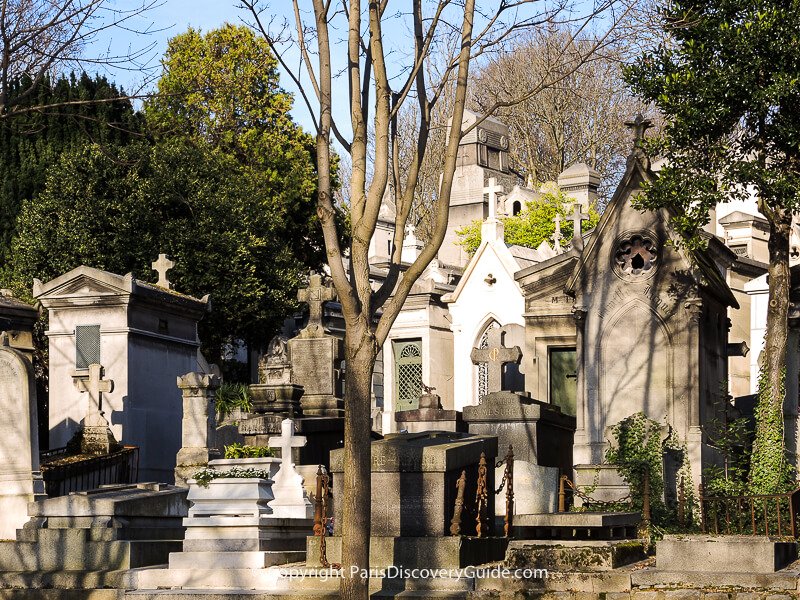
At a quick glance, the Cimetière Père Lachaise looks ancient, right? But look closely at the dates on even the oldest medieval-style tombs and moss-covered burial plots, and you'll find almost none earlier than the 1700s. That's because Père Lachaise Cemetery welcomed its first bodies in 1804, just over two centuries ago in response to a crisis that fundamentally changed Paris cemeteries.
2. Why was Père Lachaise Cemetery built?
By the 1700s, overcrowded Paris graveyards had been out of space for centuries, which meant that most bodies were buried in huge mass graves with pits up to 65 feet deep with as many as 1,500 other corpses or stored in "charnel houses" built along cemetery walls. As you can imagine, the unsanitary conditions and incompletely decomposed bodies produced a horrific stench - but because churches owned the graveyards and profited from burial fees, they resisted edicts by Louis XVI to create new burial grounds beyond the Paris city walls.
This standoff might have continued - but in 1780, decaying corpses escalated into a major emergency when a wall next to the city's biggest and oldest burial site, Les Innocents Cemetery (Cimetière des Saints-Innocents), suddenly collapsed from the weight of the bodies, and decomposing remains spilled into the basement of the house next door and killed a few of the occupants.
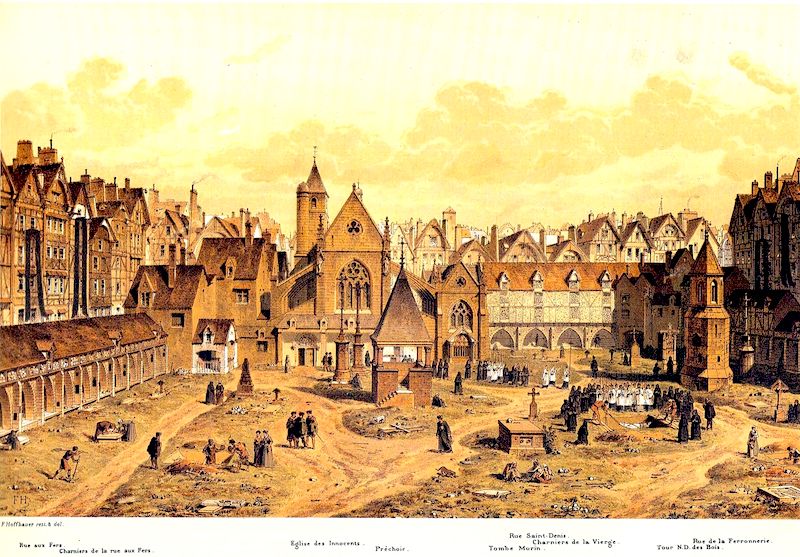
Moving the bones from Les Innocents to the Paris Catacombs (and, in case you're wondering, boiling the partially-decomposed corpses to separate bones from fat, which was used to make candles and soap) took care of the immediate problem, even though the move was an immense undertaking as around 2 million bodies had been buried there through the centuries.
But from that point on, all new burials took place in Paris's three new municipal burying grounds located outside of the city: Montparnasse in the south, Montmartre in the north, and Père Lachaise in the east.
Can you still visit Les Innocents? No - it was finally destroyed in 1787, and nothing remains today from the original site other than a fountain, La Fontaine des Innocents, which was moved a short distance from its original site to its current location slightly southeast of Les Halles market in the 1st arrondissement.
3. Is Père Lachaise a Catholic cemetery?
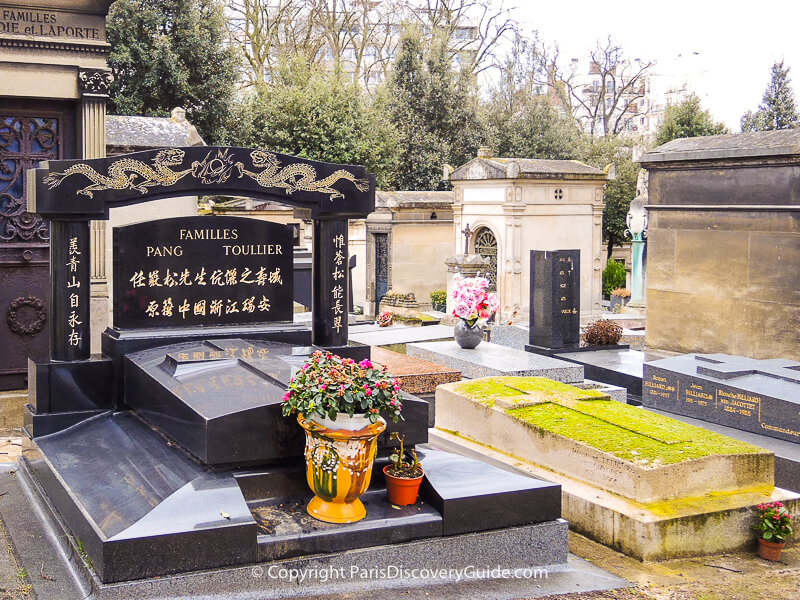
No, Napoleon Bonaparte broke with tradition by establishing Père Lachaise as a non-sectarian cemetery in 1804 after decreeing "every citizen has the right to be buried regardless of race or religion" and specifying that cemeteries should be shared by diverse religions although each could have its own dedicated space.
However, that same 1804 law specified that within large cemeteries, sections should be dedicated to specific religions.
Although most of the oldest graves bear crosses and no doubt contain the skeletons of French Roman Catholics along with a few Huguenots, there were also Jewish sections dating back to 1810 in the 7th division and 1865 in the 87th division (later moved to the 96th). A Muslim section opened in 1856 in the 85th division, which at one time contained a small mosque.
In 1881, a new law banned segregation in cemeteries, and today graves for Catholics, Jews, Muslims, Buddhists, Hindus, Taoists, Zorastrians, Spiritualists, and people with other beliefs and no religious beliefs mingle harmoniously side-by-side throughout the cemetery.
4. Why are so many famous people buried in Père Lachaise Cemetery?
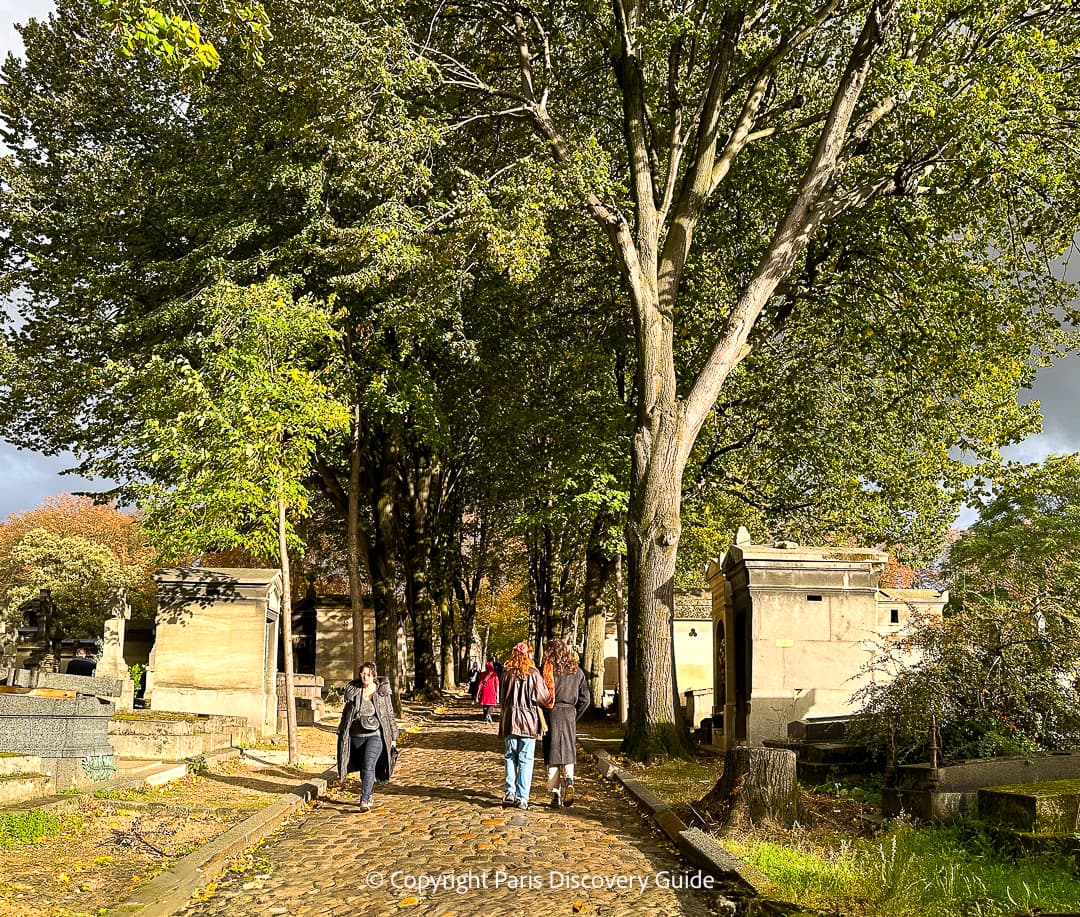
Back in 1804 when the cemetery - then, as now, officially called Cimetière de l'Est - first opened, its distant location way beyond the Paris city limits made it unappealing. The métro, which now whisks you out there in 10 minutes or less from central Paris, wouldn't be inaugurated for almost another 100 years.
Furthermore, in an era when most French Roman Catholics preferred to lay their loved ones to rest in consecrated ground next to their neighborhood church, the idea of sectarian municipal cemeteries met with huge resistance.
Faced with a lack of bodies to bury, the cemetery's administrators launched a marketing campaign.
First, they "rebranded" the cemetery with the name of King Henry XIV's Jesuit confessor, Father Francois d'Aix de la Chaise (which they shortened to Père Lachaise) to imply to Roman Catholics that the cemetery might be consecrated ground. (It is not).
Next, accompanied by a lot of promotional fanfare, they relocated the remains of a handful of carefully chosen famous dead people: Héloise and Abélard, a pair of 12th century star-crossed lovers who had become favorites of the Romantic movement sweeping through Paris at that time; a couple of famous 17th century literary giants, playwright/actor Molière and poet La Fontaine, and to appeal to those who aspired to hobnob with royalty, Louise de Lorraine, wife of King Henry III.
Their strategy worked brilliantly.
By 1817, soon after the relocation of Héloise and Abélard, Pete Lachaise became the final resting place of choice for the crème de la crème of Parisian society - celebrities, politicians, wealthy industrialists, writers, musicians, scientists, creators of fine food (this is France, after all) - plus ordinary status-conscious Parisians with enough wealth to afford one of the now-coveted plots.
5. How old are the oldest remains in Père Lachaise?

The oldest bones buried at Père Lachaise belonged to Abelard and Héloise, who died in 1142 and 1164, respectively. There's at least some chance that the skeletons in the graves might actually be theirs, since they had the advantage of dying in the days before overcrowding in cemeteries led to the bodies of everyone except the nobility, high ranking church officials, and the very rich being thrown into common graves.
The second oldest remains once were those of Louise de Loraine, who died in 1601 - but after being reburied here in the 57th division in 1805 after several other moves (including a short stint in the Catacombs), her bones were moved in a casket 1817 to the Basilica of Saint Denis north of Paris and placed in the Bourbon crypt next to Louis XVI and Marie-Antoinette. In 1975, the crypt's caskets were shifted to another spot not open for public viewing and replaced with polished black marble slabs commemorating the Bourbon royalty, which you can see if you visit the Basilica.
Therefore, the skeletons purported to belong to La Fontaine and Moliere are now the second-oldest at Père Lachaise - except since they had been buried in common graves in the former Les Innocents and Saint Joseph Cemeteries, the bones almost assuredly belonged to someone else.
Our Top Articles about Visiting Paris Cemeteries
6. Who designed Père Lachaise
Napoleon Bonaparte commissioned architect Alexandre-Théodore Brongniart to design Père Lachaise's original layout. Inspired by English gardens and the popularity of Romanticism in art and design, Brongniart created a park-like space filled with winding paths, plenty of trees, and gardens to take advantage of the naturally hilly terrain and create harmony with nature.
Lots of flowering trees, shrubs, and plants continue to attract visitors today. During cherry blossom season in March and April, you can see a succession of beautiful blooms due to the diverse cherry varieties planted throughout the gentle hills and open spaces.
Find more places to view cherry blossoms in Paris during March and April
If you visit Chopin's grave in Division 11, you'll be in the heart of this original part of the cemetery near the main Boulevard de Ménilmontant entrance, sometimes called the Romantic Section, where Brongniart's vision for a garden cemetery still rules.
As the cemetery's popularity soared, officials expanded its size five times. By the time of the fifth expansion in 1850, design preferences had shifted to the symmetry and order of Neoclassicism, which is what you can see in the geometric grid of lanes of the newest section at the southeast corner.
7. Can you still be buried in Père Lachaise Cemetery?
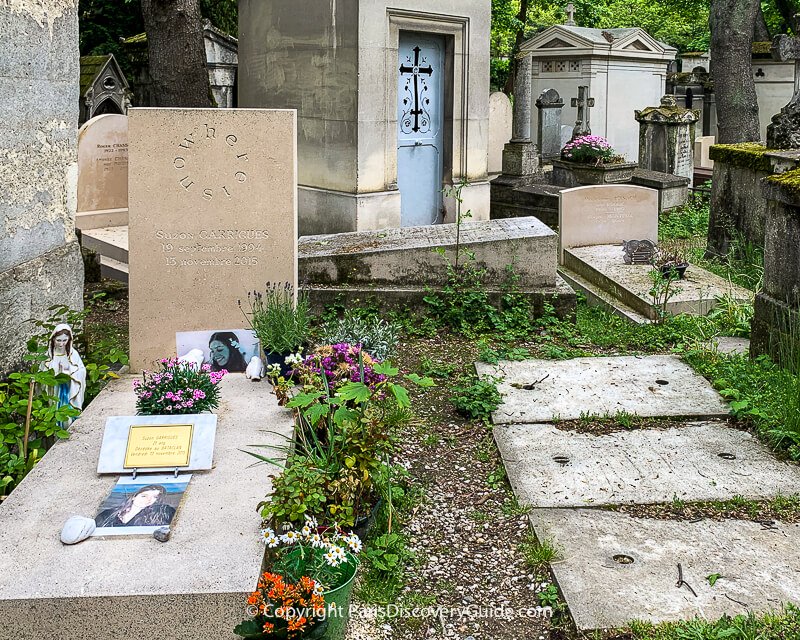
Père Lachaise continues to be an active operating cemetery, even though available burial plots are relatively scarce.
So yes, your remains can be accommodated here if you meet one key condition and have a bit of luck and some money.
First, the key condition: you must be domiciled in Paris, meaning that Paris must be your permanent home - the place where you pay taxes, vote, and claim benefits. Simply dying in Paris, like American rock star Jim Morrison did, used to be enough to qualify for a coveted spot in Père Lachaise and other cemeteries within the city limits, but that's no longer the case because demand has now far outstripped the supply of available burial plots.
Now for the luck: a spot must be available when you need it, as Père Lachaise does not maintain waiting lists nor permit you to purchase a plot in advance.
And finally, even if you are domiciled in Paris and die just as a plot at Père Lachaise opens up, you (or your loved ones) must be able to afford it. Costs have soared in recent years due to the imbalance between demand and supply, and Parisians complain that only the wealthiest get to be laid to rest in the city's most desirable necropolis.
What happens if you die in Paris but it is not your domicile, or you are not lucky enough to get a plot, or you can't afford to be buried in Père Lachaise?
The good news: by French law, you're guaranteed an individual grave for five years (after that, your bones may be moved to a common ossuary if no one has claimed them and put them in a more permanent location).
The bad news? Your grave may be in an inconvenient suburban cemetery beyond the Paris city limits - just like Père Lachaise's situation when it first opened.
8. Why does "En Perpétuité" not mean " forever " at Pere Lachaise?
The City of Paris is the only authorized seller of burial plots, and currently offers them for 10, 30, and 50 years (100 years used to also be an option), or en perpétuité - provided the descendants continue to maintain them.
The opportunity to secure a final resting spot for eternity was actually another clever Pere Lachaise marketing ploy. Up until the early 1800s, most people were interred in common graves; only royalty, high-level church officials, and a few super wealthy individuals had their own marked gravesites.
As soon as Pere Lachaise offered individual graves, Parisians leapt at the chance to have individual (or family) tombs with the concessions à perpétuité" being the most popular option.
What happens if you have a "forever" resting place, but no one continues to take care of it?
The City of Paris will try to contact your relatives or descendents, but if none step up to care for your grave, your bones will be removed and deposited in the cemetery's ossuary located in the hillside behind the Monument aux Morts memorial - and then the city will sell your plot to someone else. So that's why en perpétuité doesn't mean forever in Pere Lachaise.
But... there are exceptions. Some 33,000 memorials and monuments in the oldest part of the cemetery, the late 19th century Neo-Byzantine crematorium and the columbarium, the huge cemetery main gates on Ménilmontant Boulevard, and a few other structures are designated as protected historical monuments.
9. How many bodies are buried at Pere Lachaise?
Although Pere Lachaise contains about 70,000 tombs, the City of Paris estimates that around 1 million people have been buried there in the past two centuries.
Why do the buried bodies outnumber the tombs?
The cemetery's numerous family tombs typically contain the bones of multiple people - sometimes dozens of relatives.
In addition, the Aux Morts ossuary is believed to contain around a million skeletons (plus cremated remains from at least another million people), many of them removed from abandoned grave sites which the city then resells.
Tour Paris's Catacombs
10. Does Pere Lachaise have its own "catacombs"?
Yes, although this is not something the cemetery publicizes and it is not accessible to the public. It's actually an ossuary (common grave) and contains the bones of Parisians from all over the city as well as from abandoned tombs at Pere Lachaise.
How many remains does this mini-catacombs contain? A staggering number - at least 2 million people, and most probably a lot more. In case you're wondering, when the ossuary gets too full, bones are removed, cremated, and returned as ashes.
This mass burial site is located under the hill behind the large Aux Morts memorial created by sculptor Albert Bartholomé (who is also buried at Pere Lachaise) in Division 4.
Book Your Pere Lachaise Tour Now
- Père Lachaise Cemetery Guided Small Group Tour - During this 2-hour guided tour, you'll see the graves of Jim Morrison, Oscar Wilde, Chopin, Edith Piaf, and many other famous artists, writers, & musicians
- Haunted Père Lachaise Cemetery Guided Tour - Fun, freaky, & macabre - you'll find out about all the spooky secrets at Pere Lachaise on this popular and fascinating tour
- Stories of Père Lachaise Cemetery Walking Tour - Explore the famous cemetery while your guide entertains you with stories about the scandals, secrets, heroism, tragedies, and accomplishments of the fascinating people buried here
More to Know about Pere Lachaise: Where to Stay, Eat, & Buy Flowers
Where to Stay near Pere Lachaise
Although Pere Lachaise in the 20th arrondissement is outside of the more touristy areas in central Paris, there are some excellent places to stay nearby where you'll love the cheaper rates plus the quick/easy transportation on the Metro to other parts of the city. Take a look at these favorites close to the cemetery:
- Mama Shelter Paris East- Fun and modern 2-star hotel, with an onsite brasserie restaurant, trendy bar, and air conditioned guest rooms
Book discount deals - Eden Paris Lodge - a 100% eco bed-and-breakfast offering free bikes plus use of their fully-equipped kitchen and gorgeous garden/outdoor seating
Book best deals now - Hotel La Nouvelle Republique - Stylish 3-star boutique hotel with chic vintage decor and air conditioning in a cool location surrounded by bistros and bars.
Find best rates
Find more Paris hotels in the 20th arrondissement
Map Showing More Paris Hotels & Apartments
Use this Paris hotel map to find more hotels near Pere Lachaise:
Where to Eat near Pere Lachaise
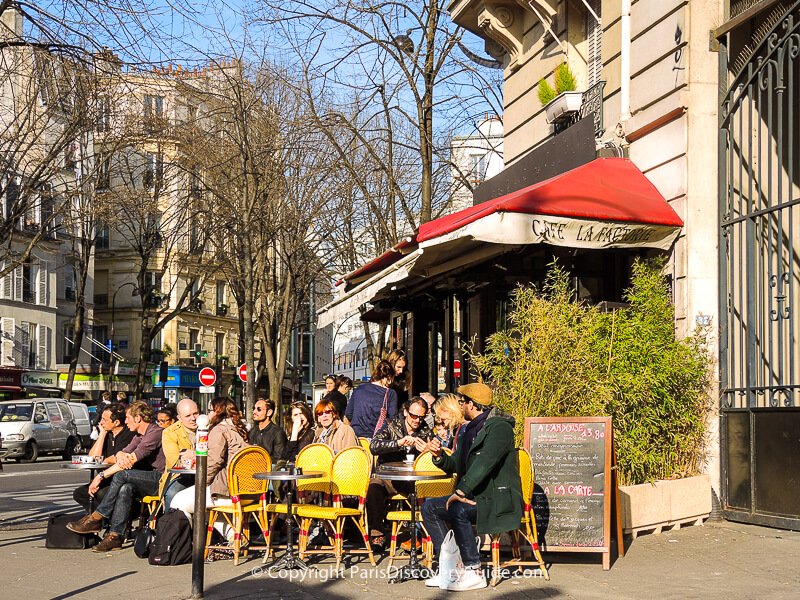
Pere Lachaise cemetery is surrounded by mainly-residential areas dotted with the small cafes, restaurants, and bakeries for which Paris is so famous.
Walk down any of the major streets or side streets surrounding the cemetery, and you'll see so many choices that you'll have trouble choosing which one.
If you want just a quick on-the-run snack, there's usually a vendor by the Pere Lachaise metro station with perfectly ripe fruit on offer.
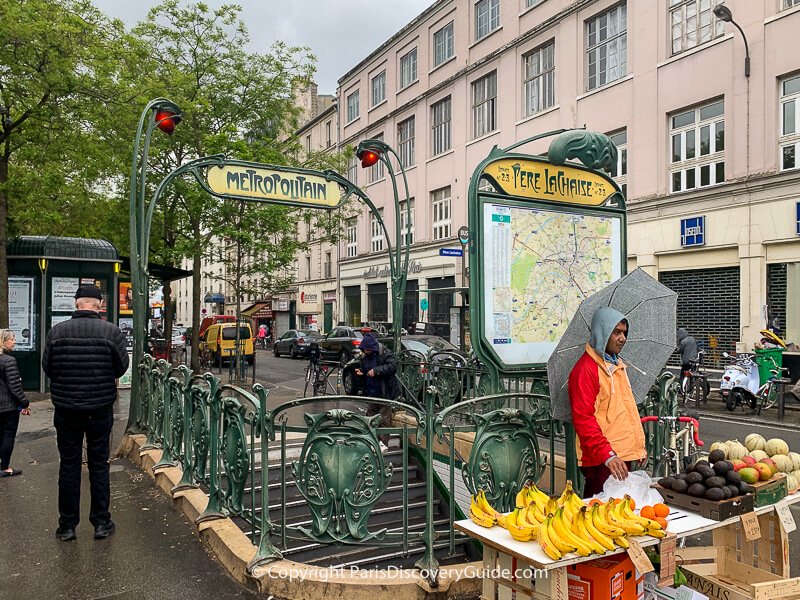
Where to Buy Flower Arrangements near Pere Lachaise
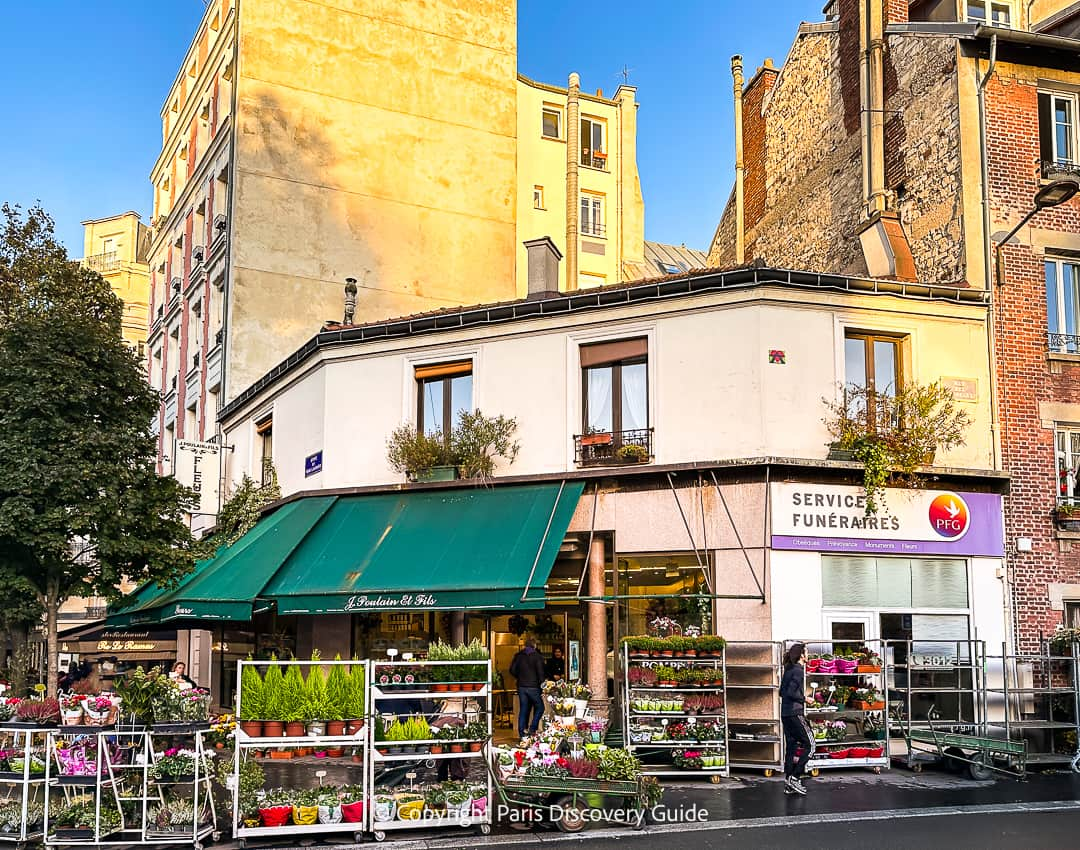
If you want to buy flowers to place on a grave at Pere Lachaise Cemetery, the most convenient places to get them are from one of the nearby florists located on the streets surrounding the burying ground.
One of the biggest is J. Poulain et Fils (shown in photo), located across from Pere Lachaise's main entrance on Boulevard de Menilmontant but you'll easily spot several others as well.
Pin Now, Read Again Later
More Articles about Top Paris Attractions
- 101 Must-See Famous Graves at Pete Lachaise
- Best time of the year to visit Pete Lachaise
- Best places to see cherry blossoms in Paris
- historical Paris churches where you can hear classical music concerts
- Why you should visit the Conciergerie, a lesser-known medieval gem and French Revolution prison
- Find out about Île de la Cité's medieval masterpieces in the heart of Paris


